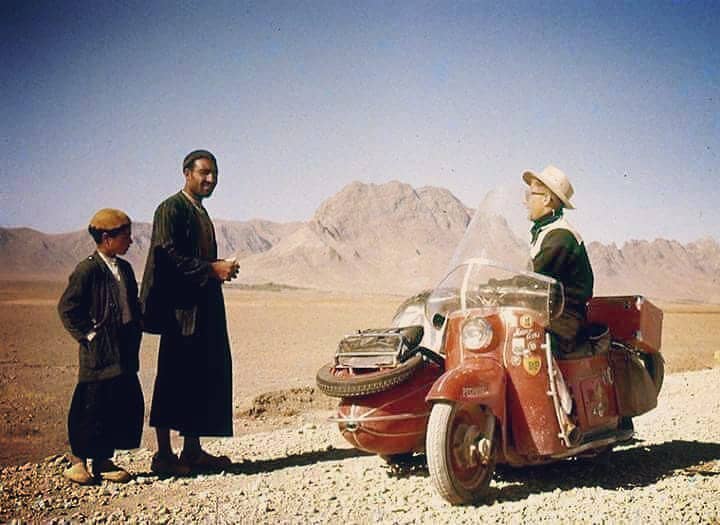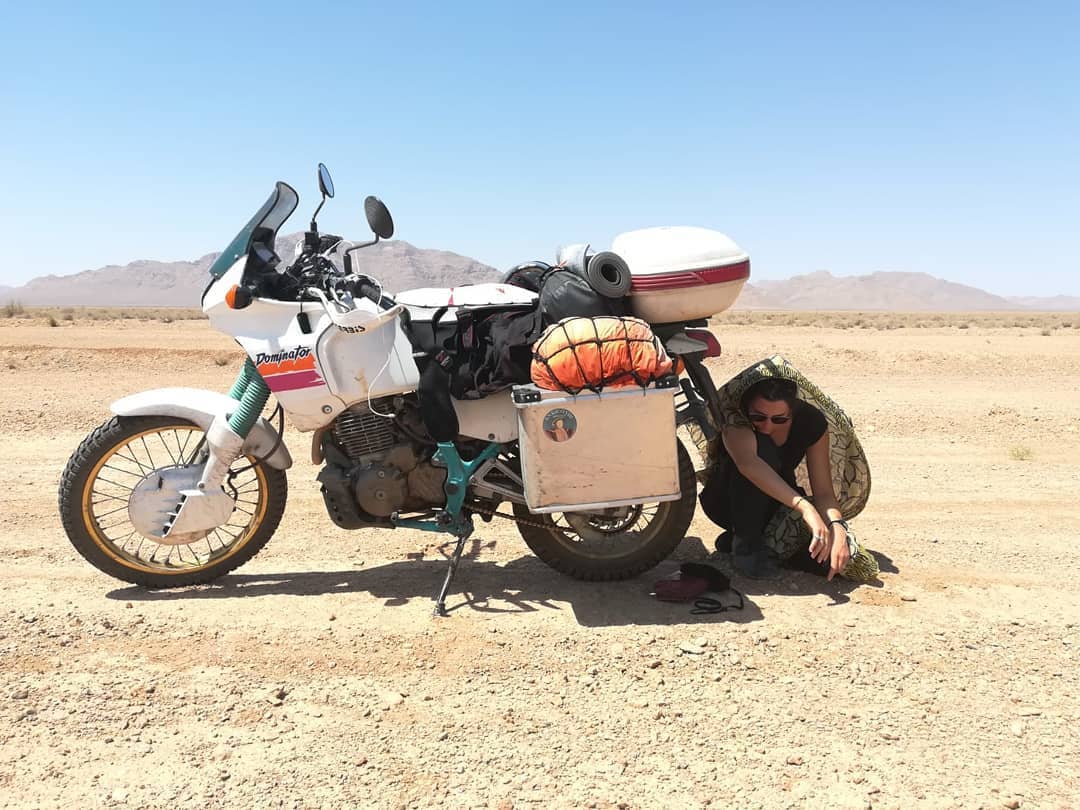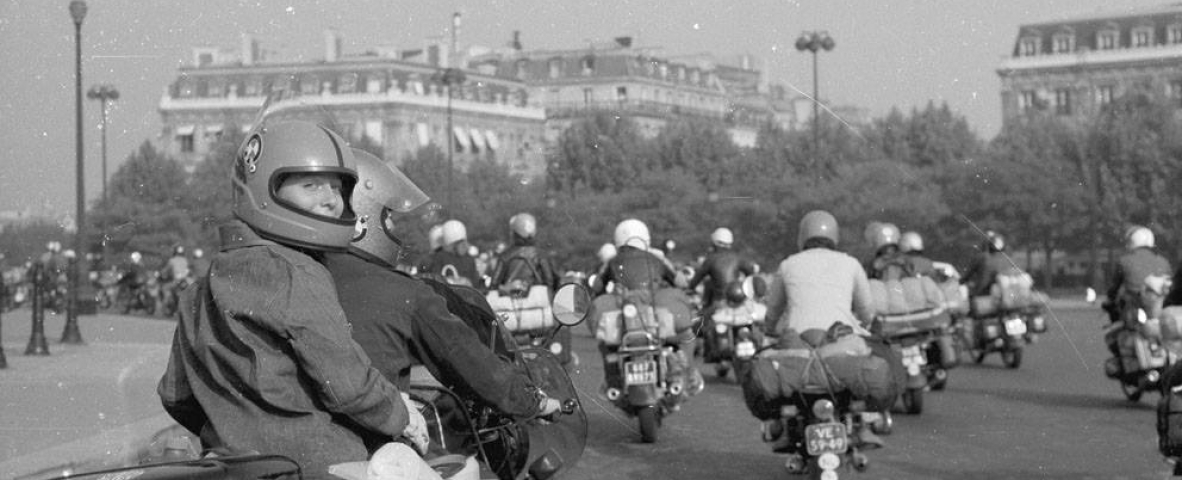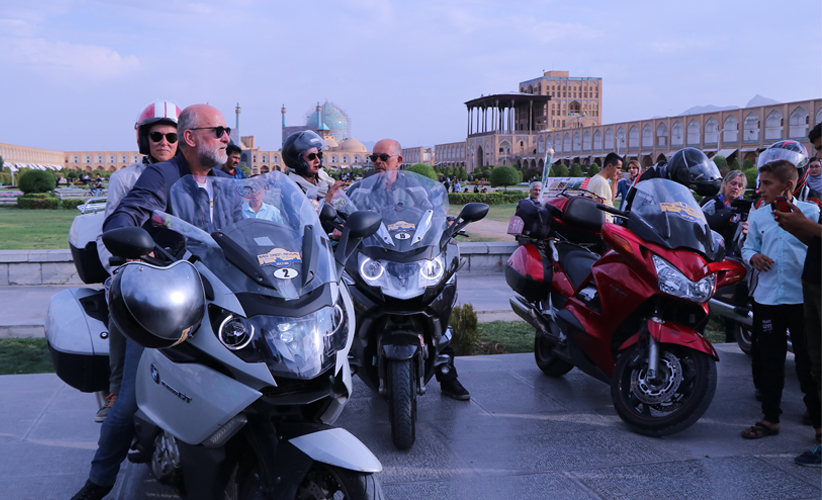Divan-e Hafiz is an apogee of Persian literature and exists in the homes of Persian speaking communities, especially Iranians. Read more
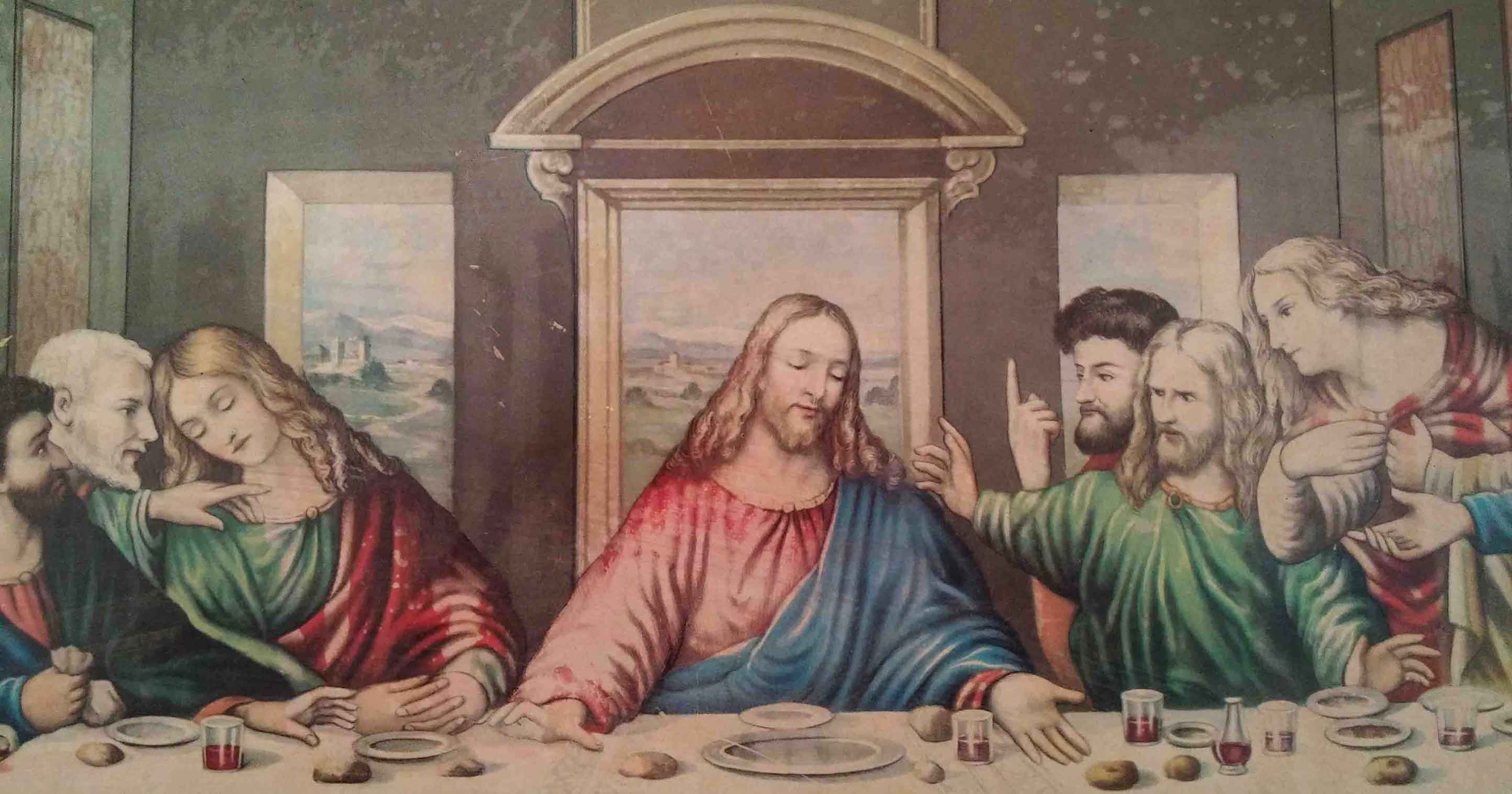
The Last Supper
Iranian Armenians
The existence of more than hundred Armenian churches and cathedral in different parts of Iran, especially in Azerbaijan, such as St. Thaddeus in the Chaldoran reign (4th century), St. Stephanos Monastery in the Julfa (9th century) and St. Mary Church of the Sham Valley (16th century) are an evidence of the presence of Armenians in this region.
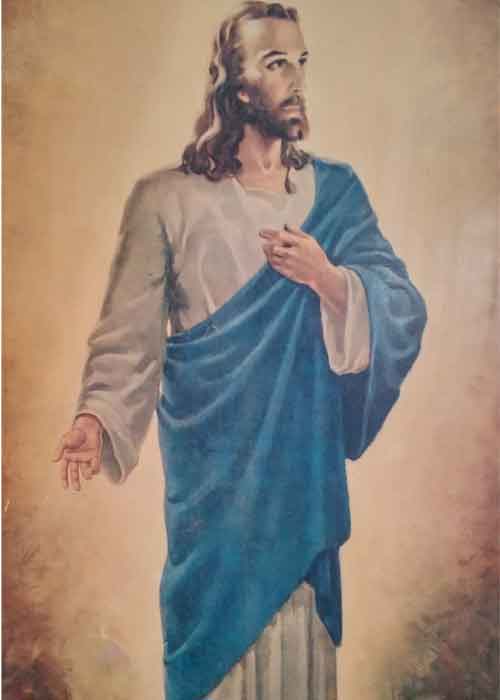
In other words, Iran and Armenia are two very close cultures from early history. Even before their high immigration there has always been much interaction between these two nations. For a long time, Armenian traders deal with India through Shiraz and Bandar Abbas in Iran. Moreover, Darius the Great has confirmed this issue on the Bisotun inscription of 517 BC.
The shared history of Iran and Armenia dates back to the 3rd century when high immigration to Iran occurred. Two countries share many historical, cultural, religious, political, and also linguistic elements. In different immigration era, Armenian settled in a different region of Iran, such as Azerbaijan, Gilan, Mazandaran, Hamedan, Qazvin, Isfahan, Kashan, Shiraz, and other cities.
Safavid Dynasty
Shah Abbas, The Great, allowed immigrant Armenians, mostly from Nakhchivan, Yerevan, and Julfa, to build a home for themselves in the suburbs of Isfahan on the Zayandehrud shores. As a result, they nominated their new residence, New Julfa for the preservation of their ancient city. The King gave Armenian merchants and artisans great privileges and even allowed them to build their churches and have their own courts. After a short time, the new Julfa became one of the most important trade centers of Iran. Finally, New Julfa in the 17th and early 18th centuries considered as a religious center located in southern Iran and also a cultural center for all immigrants.
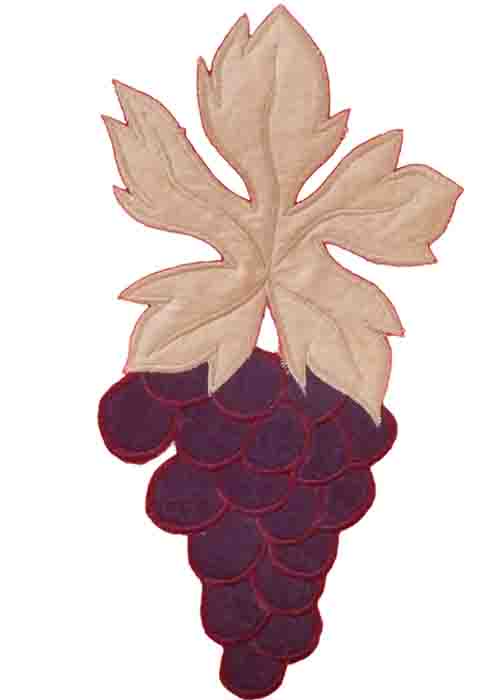
Grapes, Symbol of “Blood of Christ”
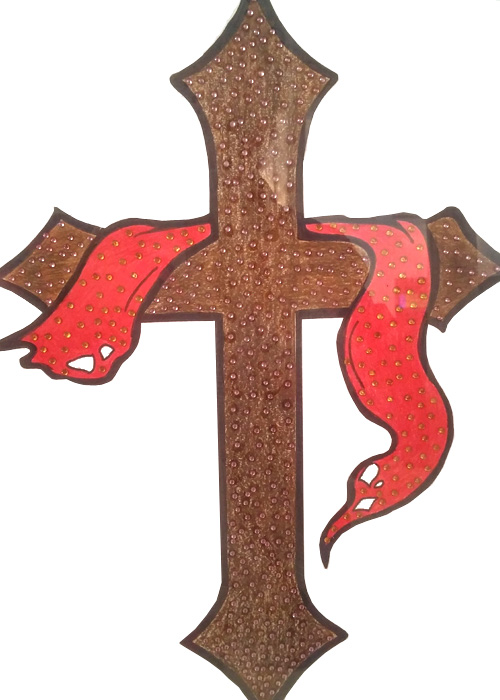
Cross, the Church of St. Mary, Khoyegan Oleia
Vank Cathedral
Vank Cathedral is one of the preeminent monument of those time built with the encouragement of the Safavid rulers. The interior is perfectly decorated and shows the aesthetic mixture of Armenian Styles and Islamic motifs, which is the characters of most churches in Iran. Furthermore, Brightly colored frescoes took years to create and have recently been restored.
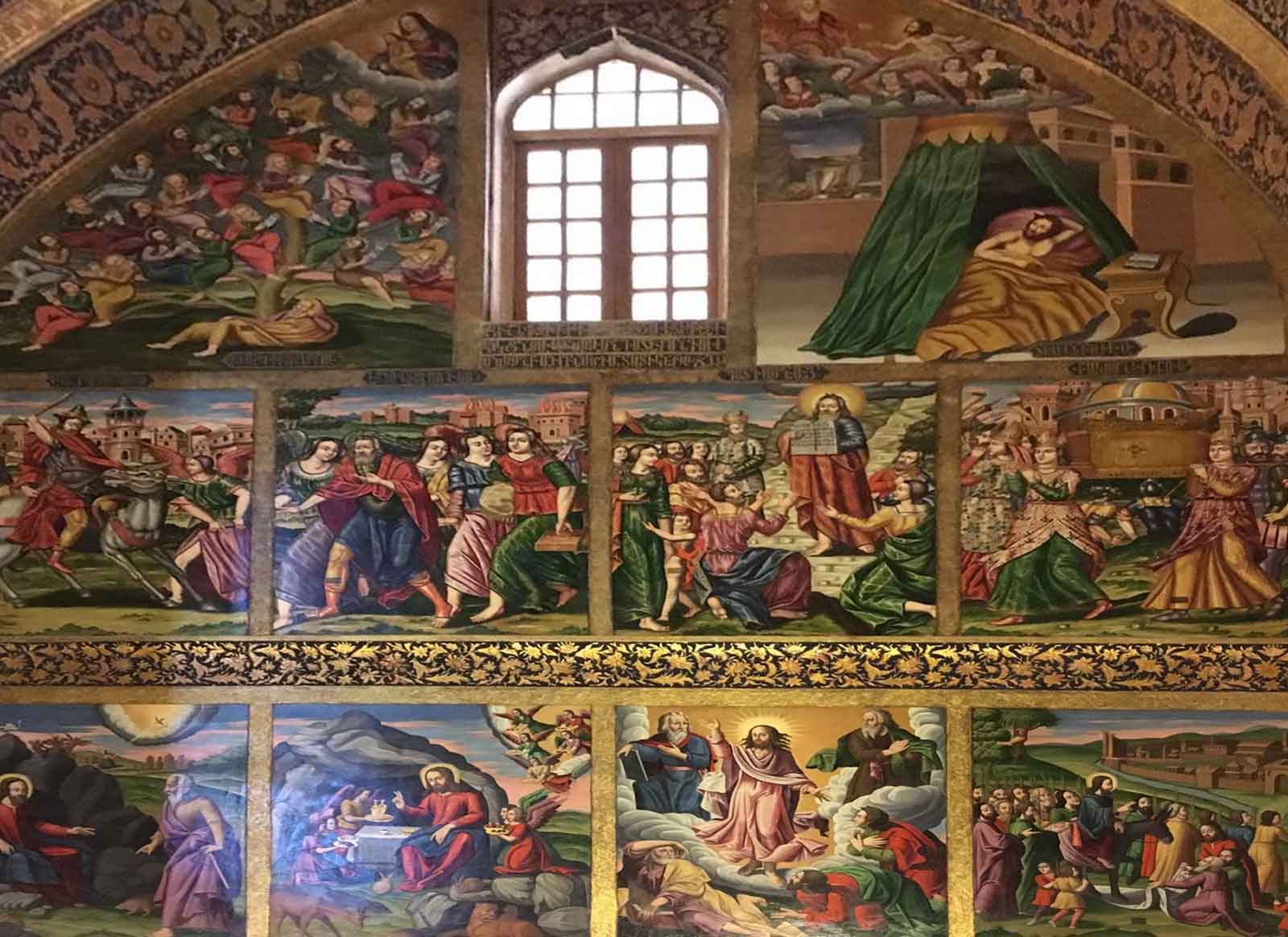
Vank Cathedral
Imam Hossain
As for the saints and the martyrs in the hagiographies of the Christian Middle Age, the life of the Shiite Imams is filling the Persian popular conscience. Still nowadays, the Kerbala tragedy is commemorated in sermons, theatrical shows and by the paintings of the naïve artists. This story can be thus summed up:
When the founder of Islam, Mohammad, died in 632, the Moslem community divided itself on the election of a successor. Ali, son-in-law of the prophet, and Abou Bakr were candidates for the Caliphate. Abou Bakr won and upon his death, his descendants Omar and Osman took over the power. It is only in 656 that Ali became Caliph. However, his assassination occurred at Koufe (Irakian town south of Baghdad) in 660. Now Iranians, although Islamised, refuse the hereditary transmission of power, so to their eyes Ali wan the sole successor of Mohammad, the three others being usurpation. Therefore, the entire Ali’s family is still today revered by the Iranians and particularly his son Hossain.
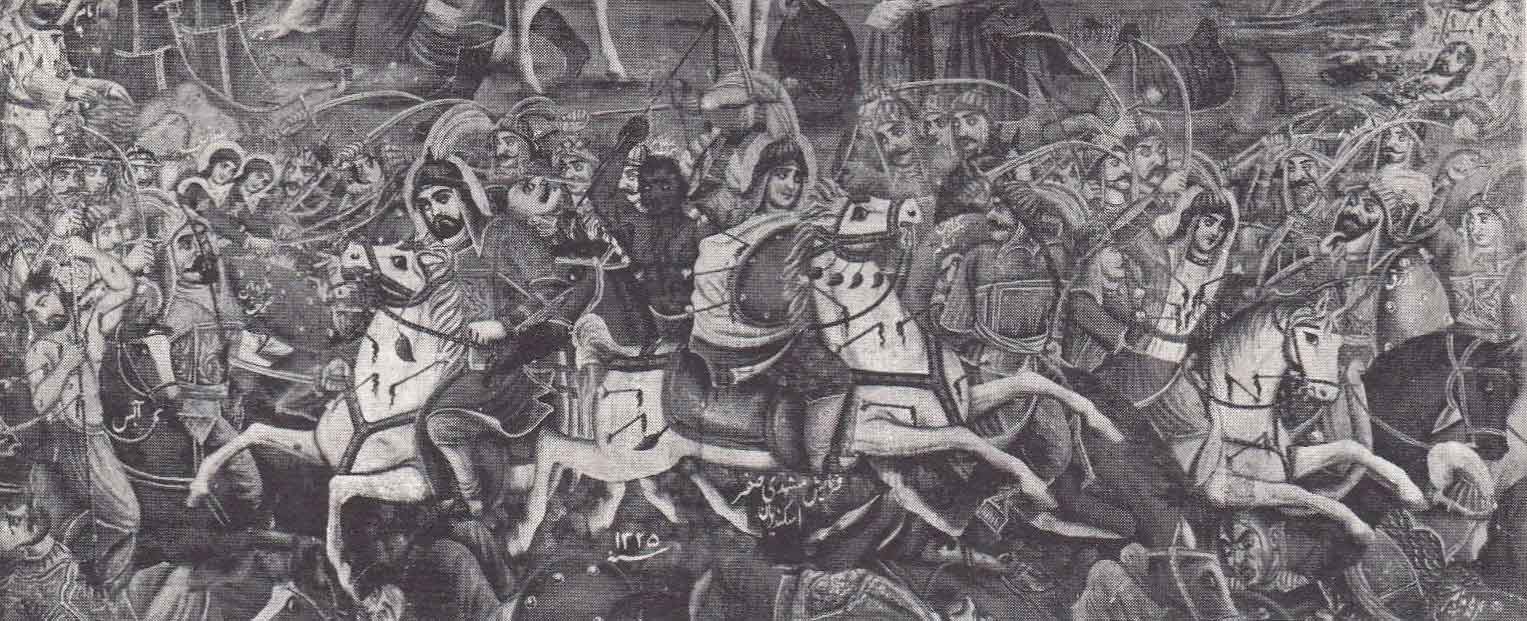
After Ali, his son, Hassan, became Caliph. Hassan died in 970 AD, and his brother, Hossain, succeeded. In 680 AD, Hossain leaving Medina with his 72 members of family and friends, to meet at Koufe the partisans that Ali had left in this town. He reached, not without many difficulties, Kerbala at the heart of Irak, in a dried up plain. Finally, his caravan surrounded by the troops of Yazid, the caliph of Damascus, succumbed in a few days, consumed with thirst.
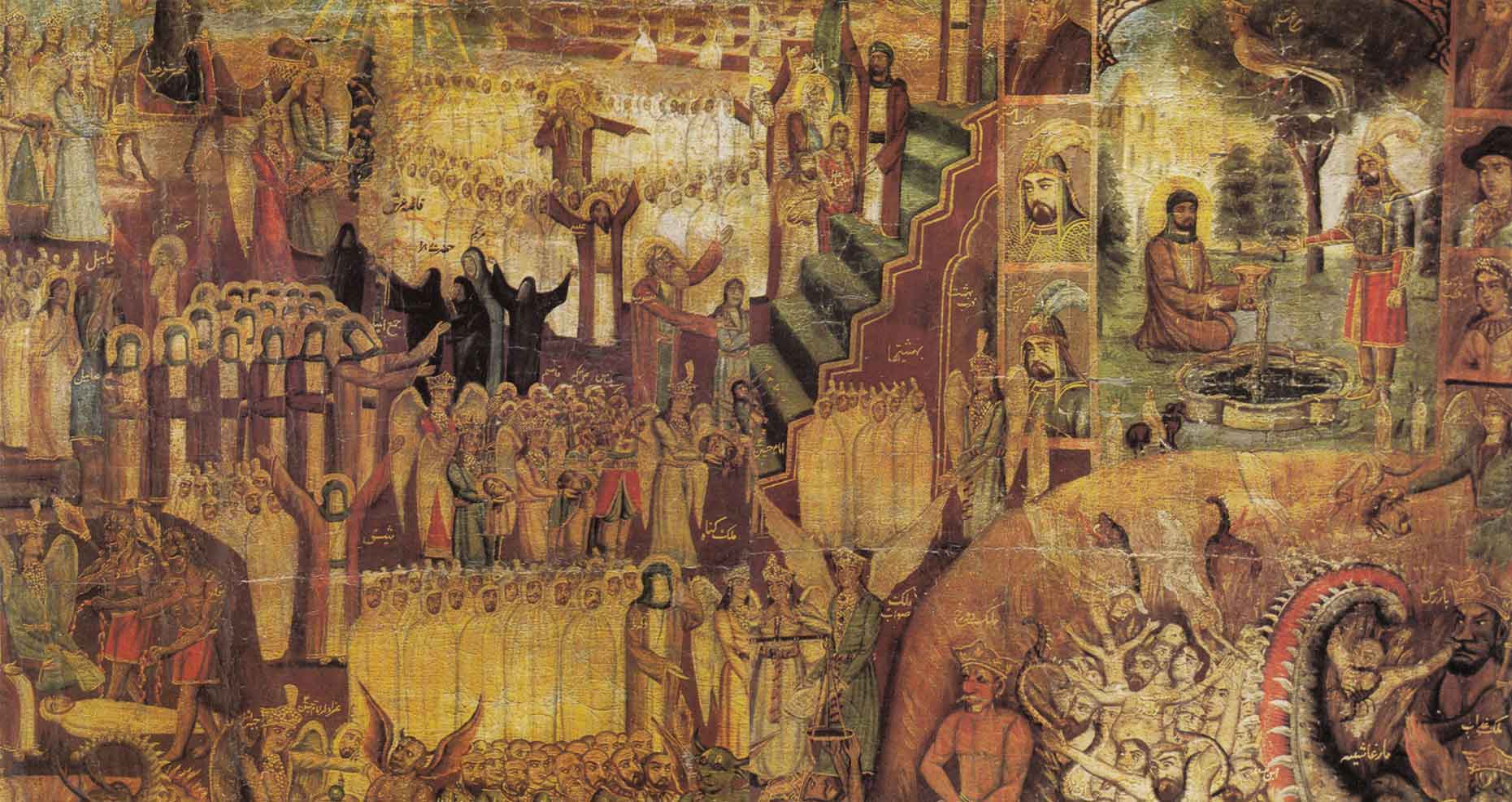
Kerbala Tragedy and Persian Writers
The tragedy of Kerbala undoubtedly inspired numerous Persian writers. From one of them, the prose writer Hossain Vaez Kachefi, the extraordinary account of Hossain’s death gives all its tragic dimension to the battle:
“When Hossain fell on the land of Kerbala, the ground began to quiver, and a clamor fell from the skies. Ten men from the enemy army dismounted, drew their swords and started forward. Each one tried to outdistance the other to cut Hossain’s head and receive as a reward a gift and a parade dress. However, each time that one of them approached, Hossain opened his eyes and looked at him, and the man was falling back full of shame.
At last two damned scoundrels – Sinan ben Anas and Shemr son of the cuirassier – went forward. Sinan wanted to reach there first, but he was overtaken by Shemr who squatted down on Hossain’s chest. Opening his eyes, he said to Shemr: “Who are you?” The damned named himself. “Draw from your face your veil of mail,” said Hossain. As soon as he had uncovered his face, Hossain saw that his teeth, such as those from the swine, were protruding from his mouth.
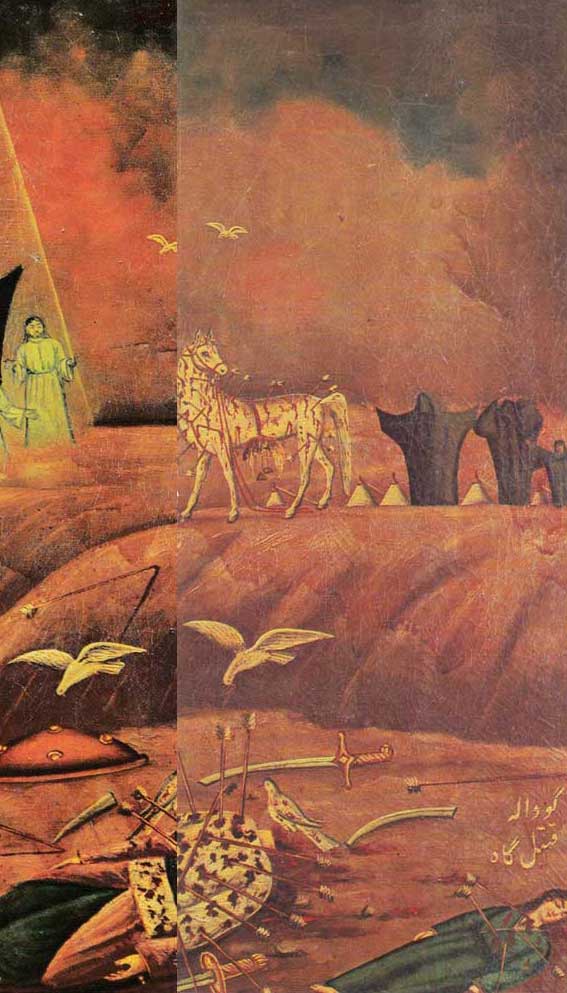
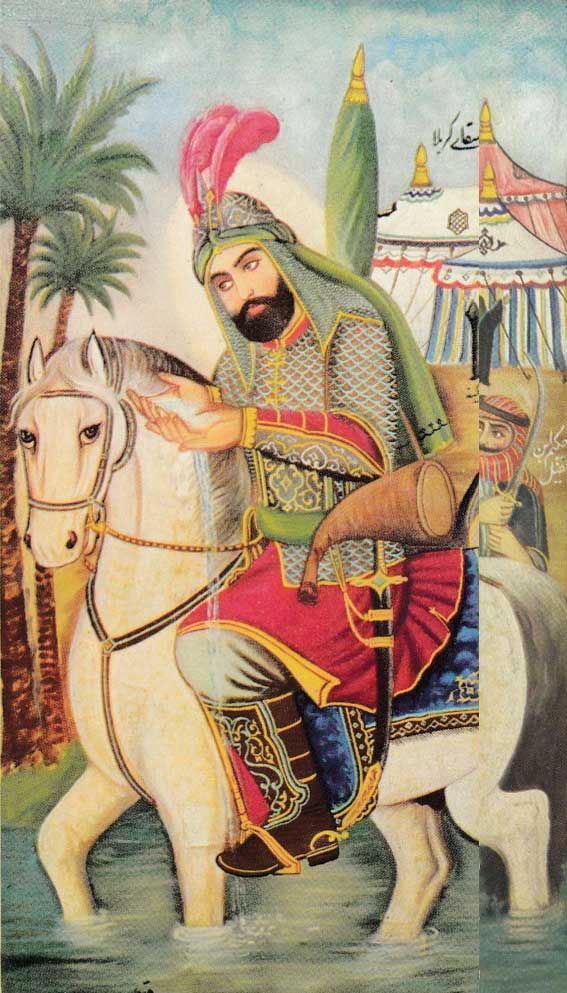
“Indeed this is a true sign,” said he. Then he ordered him to uncover his chest; doing so Hossain saw there the marks of leprosy “this is indeed the other sign, my ancestor the prophet spoke the truth” he said. He added “last night I saw in a dream Allah’s Prophet; he announced to me that the next day, at the hour of the first prayer, I shall rejoin him and that my murderer would have the aspect that you have: the signs that he showed to me are yours. Do what you will, Shemr! Do you know which day it is today? – I do, it is Friday, day of Achoura. – Do you know what hour this is? – Yes indeed! It is the moment to intone the sermon and to pray in assembly.
– At this hour the preachers of the community founded by my ancestor Mohammad are intoning the sermon from the pulpit and lauding this august ancestor; this is how you act towards me! Shemr! You are kneeling on my chest, where the Prophet laid his face; you will strike with your sword this throat that he kissed. Shemr! Arise! Free my chest – for it is time to pray – so that I may turn towards Mecca and pray, without even having been able to accomplish the ritual ablution. I have inherited from my father Ali to be struck fatally during prayer. Therefore, while I am praying; do what you will!”
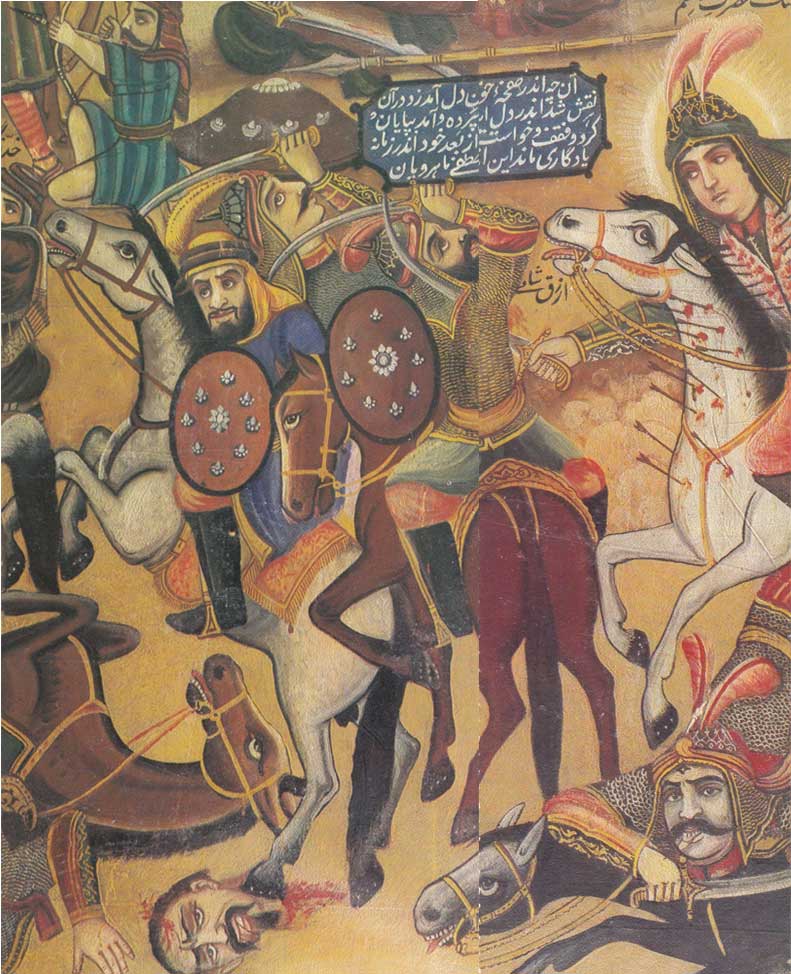
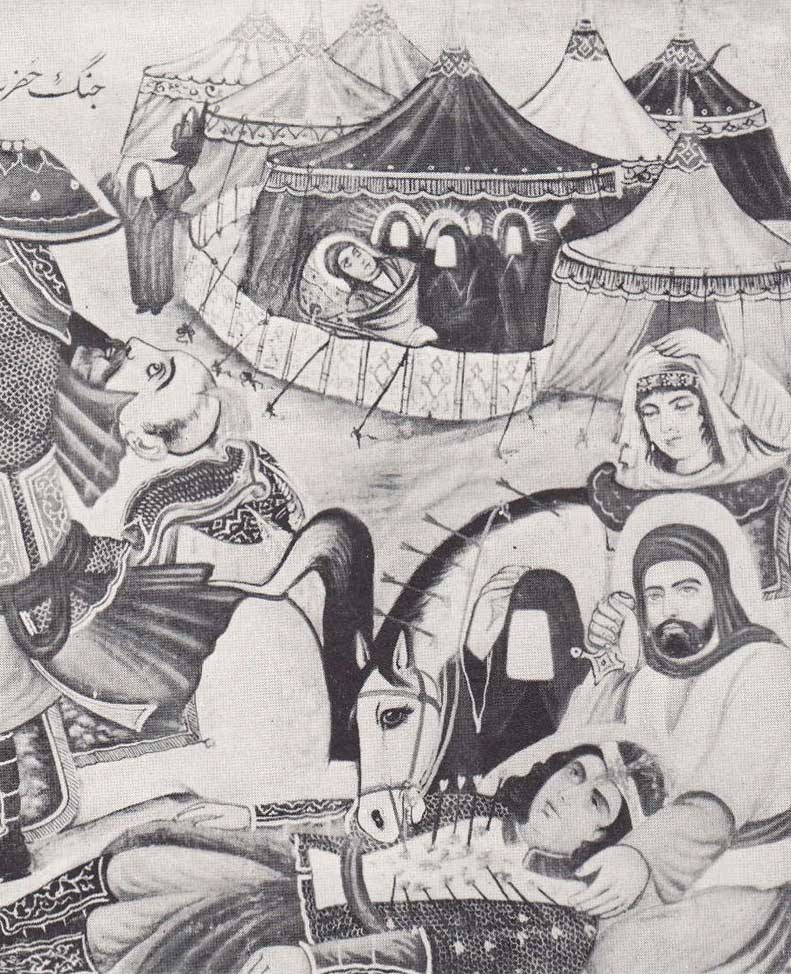
Shemr arose and exposed the chest of the Imam who still had the strength to turn towards Mecca and begin to pray. However, Shemr, not having the patience to await the end of the prayer, made his Highness, seen by God, partake of the martyr’s drink. “Surely we belong to God and return to him!” At that very moment, a storm burst in the holy places of the invisible universe; the poor sinners uttered a cry to the world of the Almighty. The sun that illuminates the world lost its splendor; the moon which adorns the universe fell into the pit of total obscurity. The angels’ waiting filled all space; the djins around Kerbala burst into sobs; the robe of the sky became stained with blood; the seas lifted their waves of sadness to the zenith; the mounts expressed their grief with pained and heart-rending sounds.
Muharram in the Mirror of Traditional Paintings
This episode of a strong tragical force, forms the subject of an important number of naïve paintings, as the story-tellers did find there an easy theme for dramatical development and meditations. So one can see, a multiplication of imagery, sometimes closely sometimes very loosely related to it, and in this case mainly due to the imagination of the painters and the tellers.
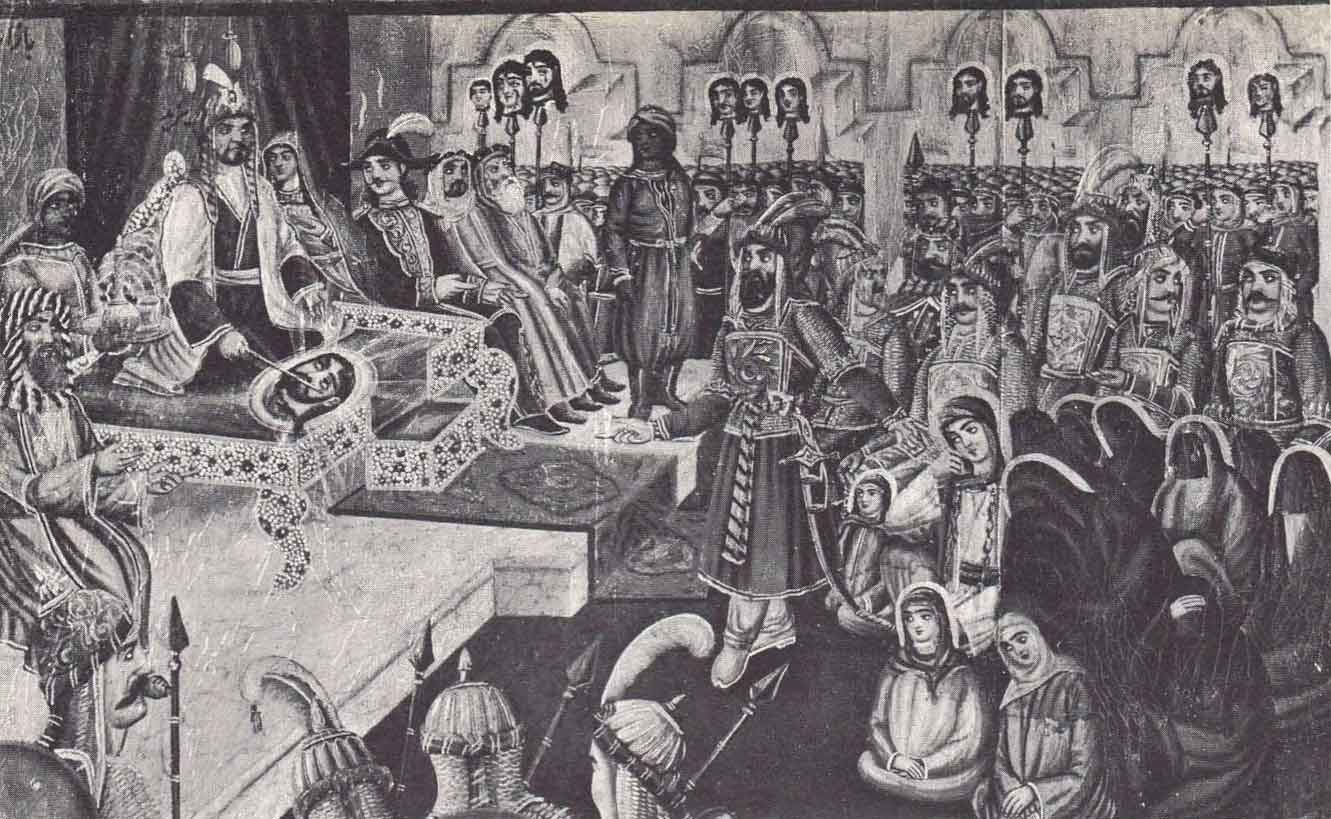
The martyr of Hossain’s newly born son, Ali Asghar, to whom the Angel Gabriel in dervish disguise brought water.
Furthermore, the martyr of Abbas, Hossain’s brother, who goes to fetch water from the Euphrates to quench the thirst of his family, had his hands cut off. Shemr, Hossain’s murderer, claiming the Caliphate to Yazid. The repentance of the Caliph of Damascus when hearing Saint Zeinab’s words.
Moreover, lastly the terrible revenge of Emir Mokhtar over Hossain’s torturers, subject rich in imaginations of rare cruelty (Mirdashti Publication).
Trip by Motorcycle
Travel has a great variety. Some travelers lost their mind about seeing roads! They begin to explore the world on foot; some are so-called Hychhayk. Some travel neither on foot nor public vehicle, but by their own vehicle. They prefer self-drive. If this is a car or motorcycle, it’s easier to work.
Moreover, motorcycle touring is a kind of tourism that needs a motorcycle. Since 1915 motorcycle touring has been held. When one travels by motorbike, the journey becomes the destination. Iran with its dazzling scenes and most welcoming people would be the top destination for motorcyclists to be chosen. It just needs to have an adventurous spirit, love of riding a motorcycle and armed with its license.
Why Motorcycle?
Traveling by motorcycle has its own advantages like feeling freedom, you can go anywhere, anytime your heart wishes, making the connection to the World around You. Unlike buses and trains, where walls, curtains and the ceiling restrict your view of the road! Being a budget, traveling with motorbikes is significantly cheaper than any other kinds of travel and Generating adrenaline makes riders feel empowered.
Raid Orion Revival
Back in time there have been thousands of travelers who visit Iran by motorcycle, for instance, since July 1972 nearly a hundred bikes have been ridden more than 7000 km of roads, A long journey, from Paris to Isfahan in Iran.
Lois Pryce also is one of the Adventure travelers who rode her Motorcycle solo 3,000 miles across Iran in 2 months and wrote a book about her journey and named it, Revolution Ride. According to what she says, of all her adventures, visiting Iran has affected her most profoundly.
As soon as I crossed the border it became apparent that the Iranian people were going to make me fall head over heels in love with their country
So pick up the best sceneries through the perfect nature and outdoors. It’s an opportunity to experience varied geography and culture in Iran.
Minakari
Minakari is the great art of soil and fire that makes a combination of a world of thousands of colors and designs stay on unique metal wares.
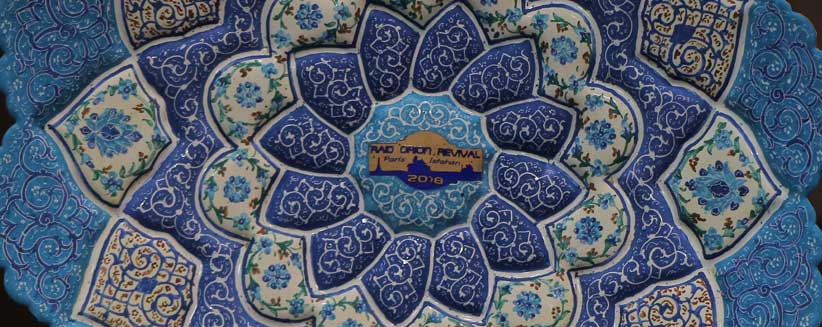
If you turn your glance from the sky to the blue tiles of the mosques, your eyes follow the trace of the azure heaven. In almost every store around Naqsh-e Jahan Square, great designs of dexterous Safavid artists glitters in Mina works. In other words, Minakari is the great art of soil and fire that makes a combination of a world of thousands of colors and designs stay on unique metal wares.
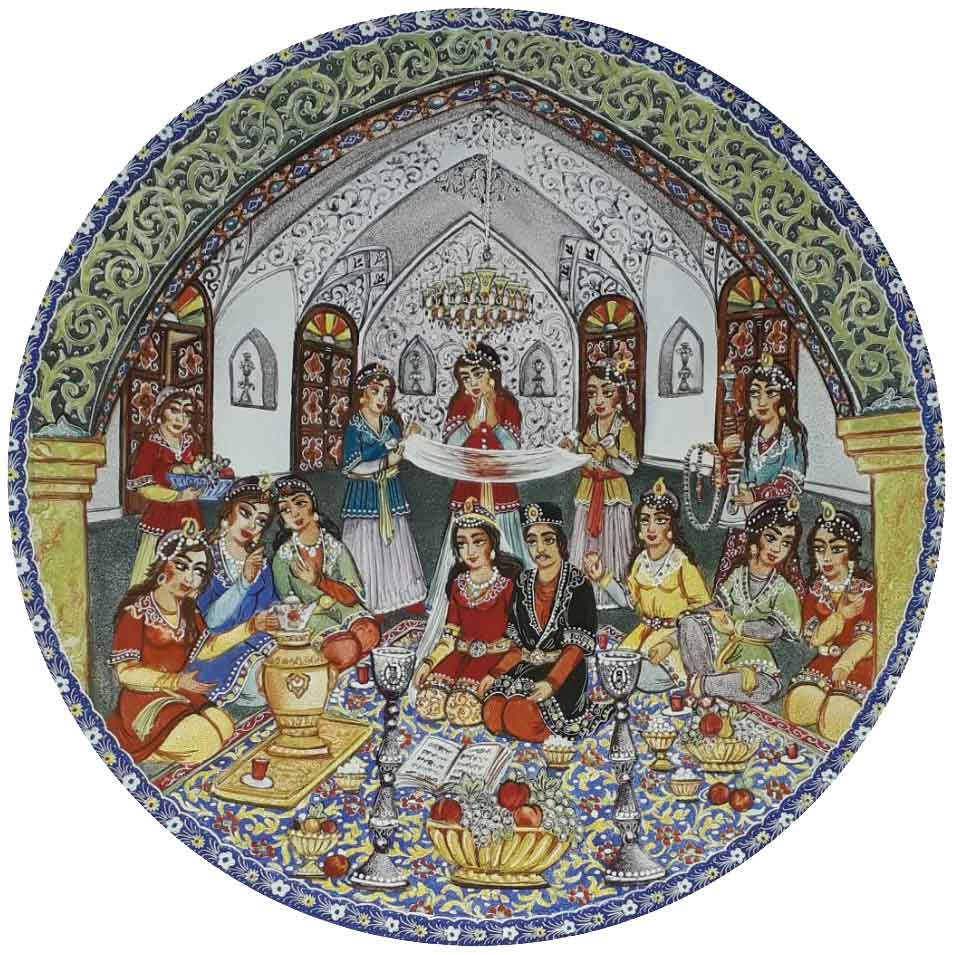
Minakari n Isfahan
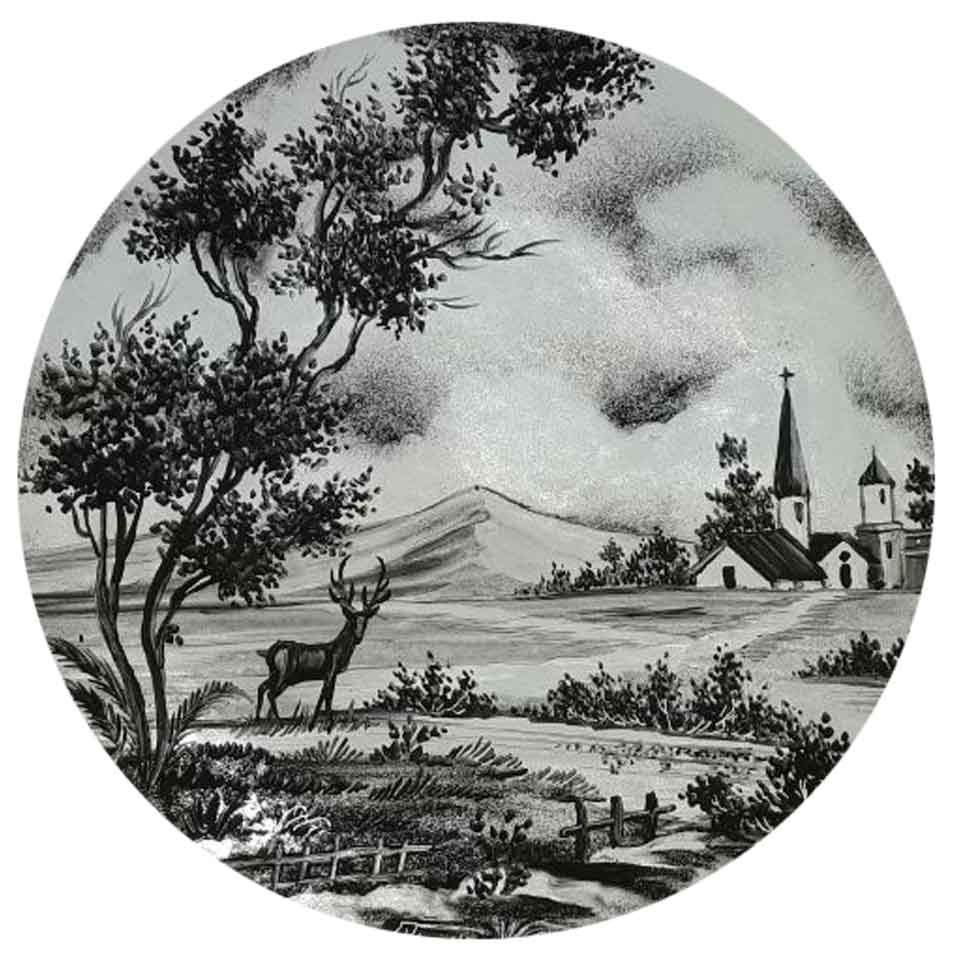
Minakari, Art of Soil and Fire
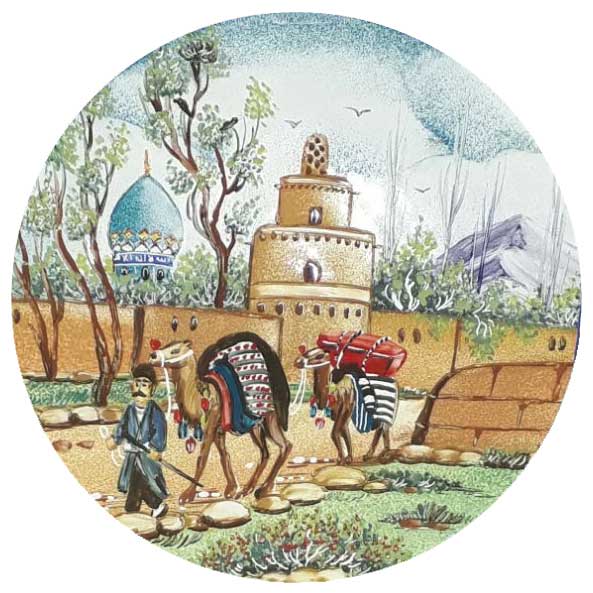
The Old Isfahan
The everlasting floral designs date back to the great ancient civilizations. However, the exact date of this art is not definite. Two of the orientalists attribute it to Parthians and Sasanians. Furthermore, the fluctuation of interests in this art shows that it has always had its popularity among other types of arts. Also, Minakari reached its climax in Mogul dynasty and like other art forms descended in the Qajar era.
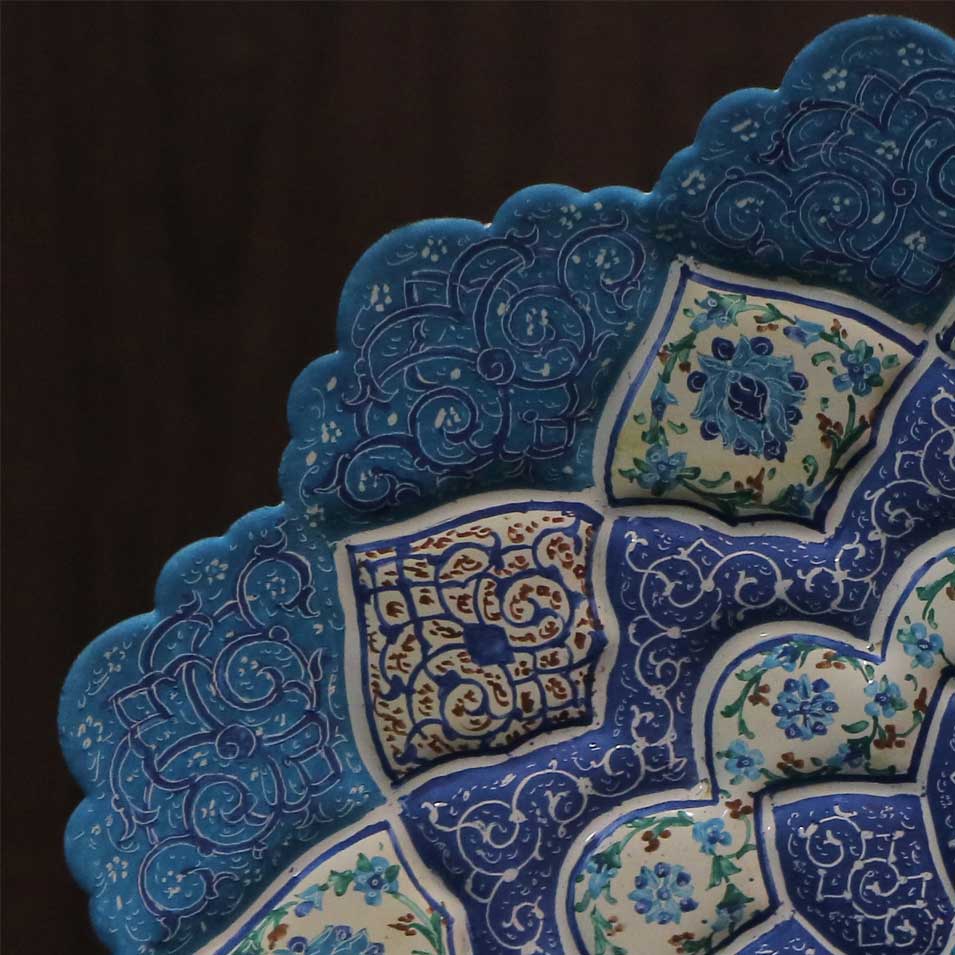
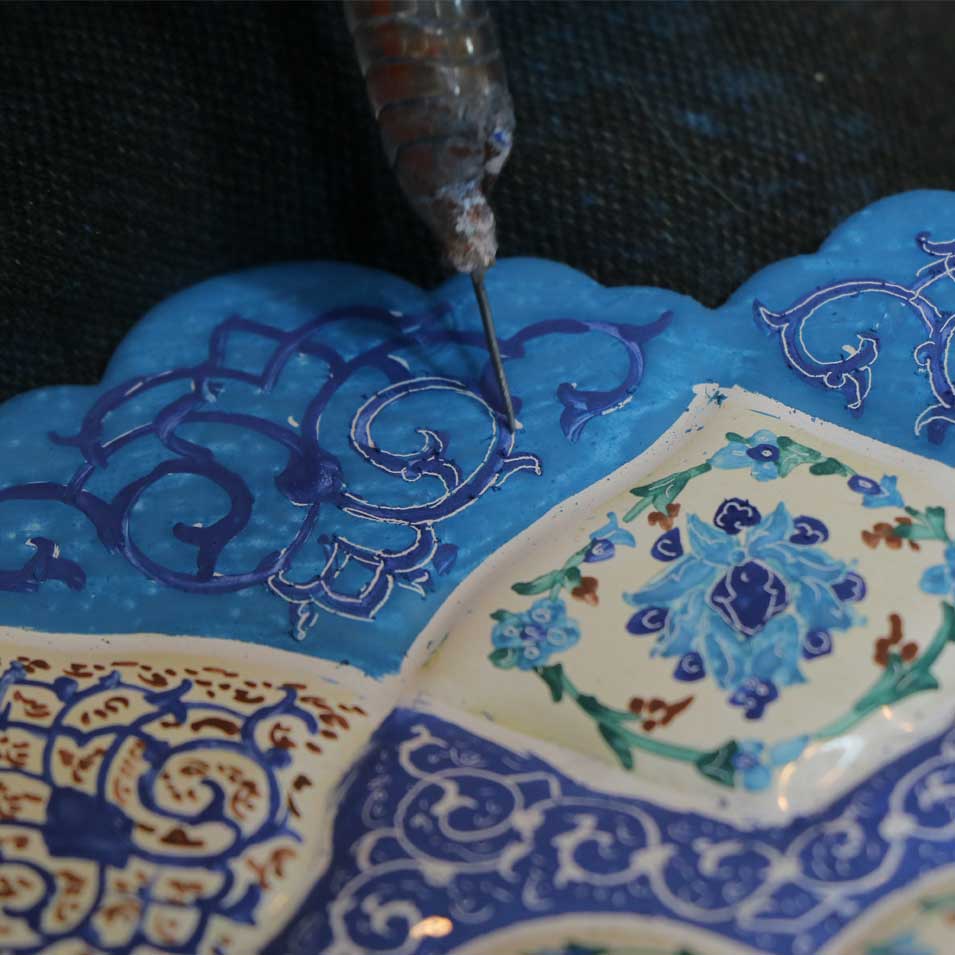
After stabilization of the white glaze on smithed-copper, it is time for the artist’s creative mind to convey arabesque designs with different colors on the blue background. Besides that, the Minakarists of Isfahan eternalize Arabesque designs of the azure domes tiling. The colors settle on the designs and shine like the domes.
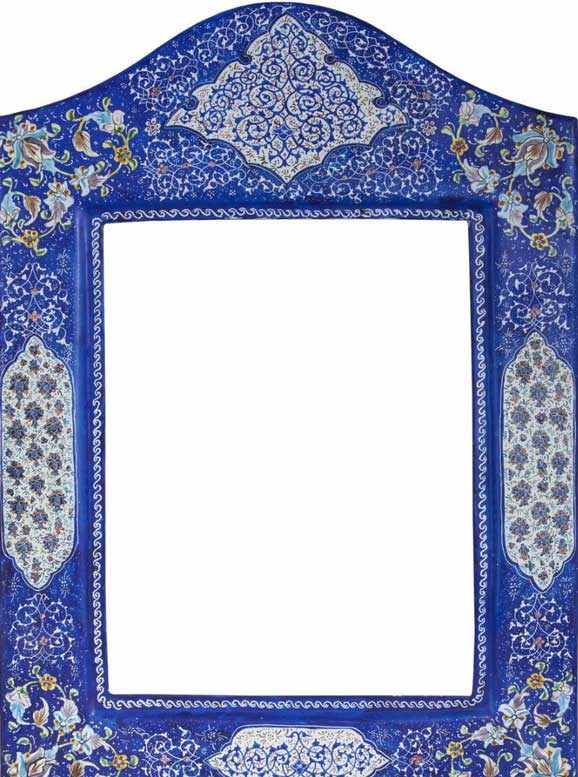
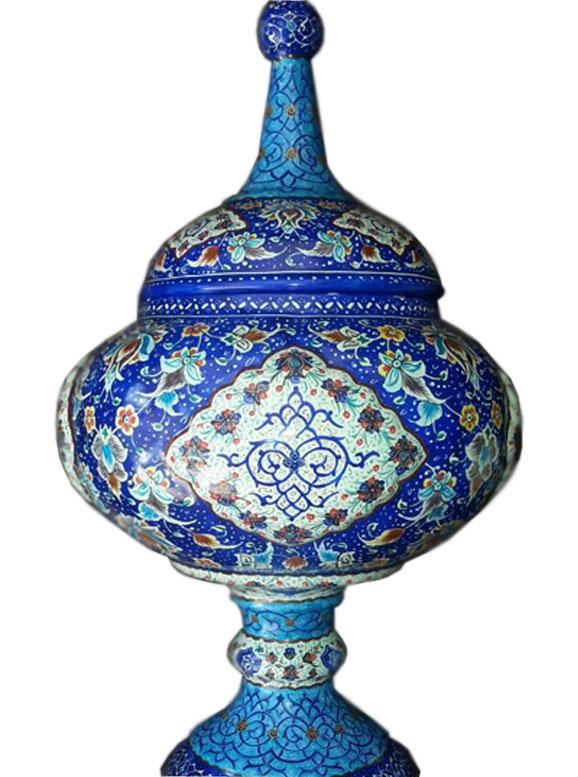
Minakari Market Change
Traditionally, artists used mineral and herbal colors, but today artificial colors are also used.

Minakari Workshop in Isfahan
The original Mina works had a blue background. However, today green and red have come to the market. From decorative objects to tableware and jewelry, nowadays you can undoubtedly find enamel works with Minakari designs. Some of them combined with other kinds of art.
Varzaneh Desert
Varzaneh is certainly ranked as one of the most tourist spot of Iran which is approximately 123 kilometers away from Isfahan and 237 kilometers from Yazd. Silence and peace of Varzaneh charm everyone who wants to escape the hustle and bustle of modern life.
Stroll bare feet on the spectacular endless dunes to find an untouched spot. It helps you to leave your mind free. In addition to quietness and peace, there are some exciting activities you have to do to fulfill your desert experiences. Besides that you can surf the sand with FWD and ride a camel to take photos on it.
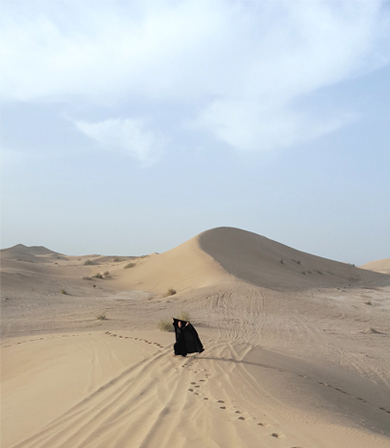
Varzaneh Experience
When the day is over, you can climb up the dunes and wait for the sunset to see the blend of color behind the golden dunes. An hour later, the stars walk into view! What is your feeling when you lie down on the sands, and the full of stars sky is above you?
Moreover, women’s costume of this city makes them unique in the whole of Iran. They wear white chador instead of the customary black chador. In fact, some believe its root is related to the Zoroastrianism religion in old Varzaneh which white was a holy color or it is a suitable choice for the tropical region of Varzaneh.
“Getting off the beaten track is one’s life experience you have to do.”
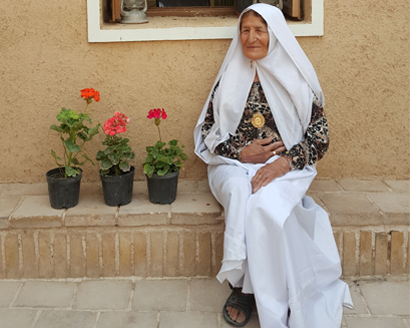
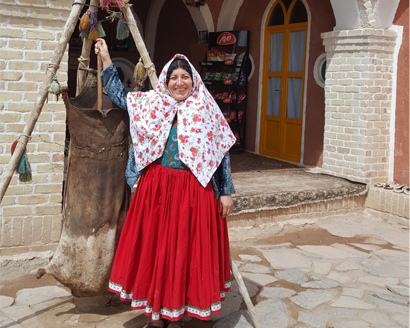
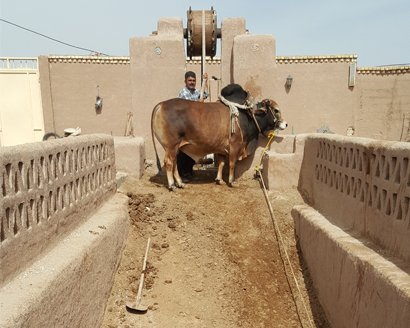
Ox-well Complex
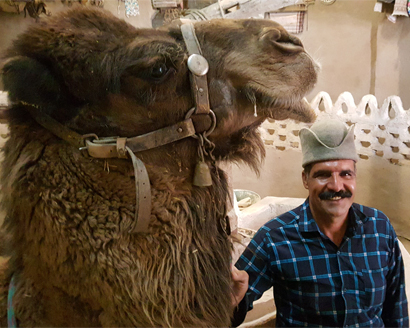
Camel Mill
Varzaneh Attractions
Camel mill, Ox-well Complex, and Pigeon tower are other Varzaneh attractions that catch the tourists’ attention. Camel mill points out the old system of grinding wheat by male camel. In the old days, a man was singing the folklore songs while pulling the rope of camel. Also, you can see the same system in Ox-well Complex while a bull starts working and taking the water from a well with the song of his owner. To put it another way, dry regions like Varzaneh, people’s life directly relates to the agriculture. Pigeon tower is the site where the droppings provided by the pigeons are used as the fertilizer by the farmers.
Hafizi Shirazi
Khwāja Shams-ud-Dīn Muhammad Hāfez-e Shīrāzī is literary wonders of the world. Hafiz quotes have been translated into different languages. Besides that, his skills of poetry have been appreciated by many preeminent writers and philologists such as Goethe and William Jones. Hafiz is the most beloved poet of the 14th century and was born in the “City of Roses and Nightingales,” Shiraz. His books are as the most prominent Persian literature.
In fact, they founded in the homes of almost all Iranian, who use his verses as a proverb in their speaking and memorize his poems by heart. His poetry has an active mystical quality that worships the joys of love, wine, courtship and also targeted religious hypocrisy. His verses can be interpreted in different ways. Therefore, people read them and believe Hafiz will give them a piece of advice. Hafiz reminds us that regardless of our efforts, life is like a river flowing, so it is unfair to take it that seriously.
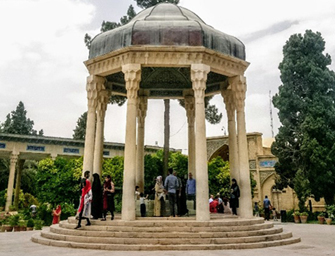
Tomb of Hafiz
“Openly I admit, with much joy and such glee
Enslaved to your love, from both worlds I am free.
As a bird of Paradise, to parting, I did agree
Fell in the trap of life and worldly tragedy” (Hafiz Quotes)
Hafiz’s tomb & its wonderful garden is the best place to know Hafiz’s position in the nations’ psyche. When entering the Hafiz Complex, the beautiful greenish roof of the tomb will catch your attention. Hafiz’s tomb is not just a grave to visit, the inscriptions on his tombstone give you an insight into the charm of wine and love and realities of life.
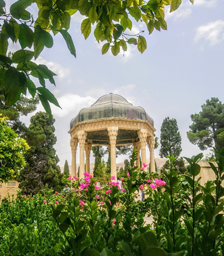
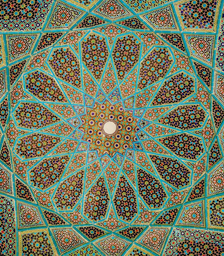
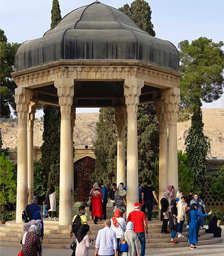
Be with us for enjoyable moments. Listen to Persian poetry and learn how to tell a few verses in Farsi. Furthermore, we lead you through the Literary History of Persia and read you love stories. You may also like to ask Hafiz what’s on your mind to give guidance through his verses.
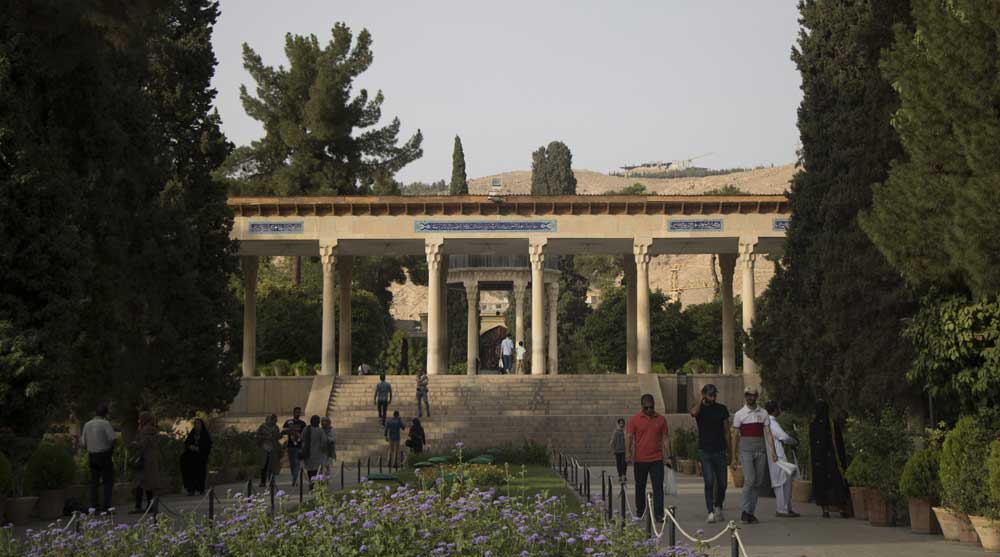
Do you know about Abarkuh Cypress?
Located in Abarkuh, 140 km to the west of Yazd, the giant cypress 25 meters tall, attracts travelers’ attention from kilometers in the distance. There is no reason not stopping in the heart of Iran on your way between Shiraz and Yazd. The old cedar has more than four millennia of age. That is why it considered as a beautiful place to stop. Regardless of its oldness, the tree deserves to be noticed. Since its beauty and evenly grown crown of the tree with 14.07 m diameter makes it the most attractive cypress in the world.
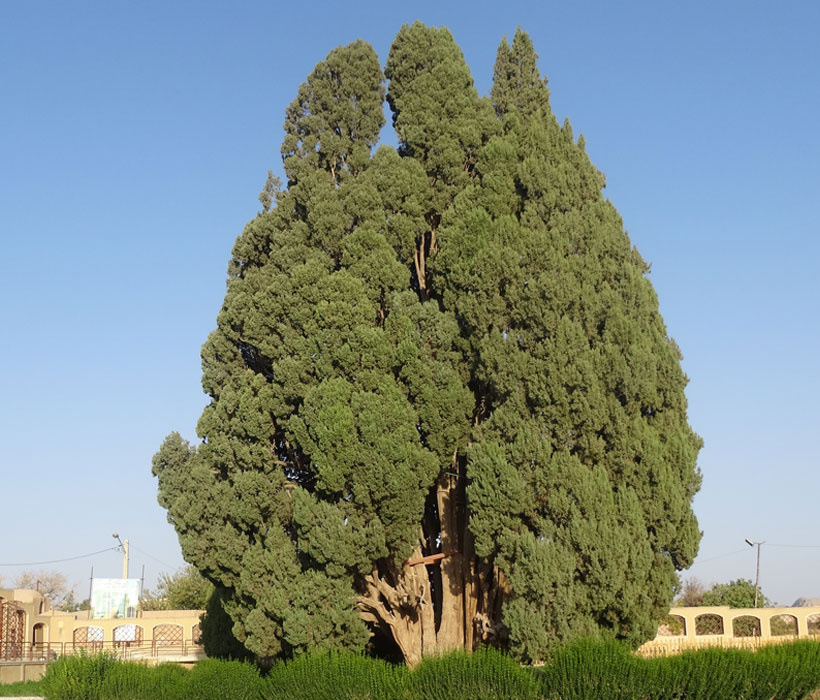
Zoroasterian Tree in Abarkuh
Zoroastrian Tree?
The Persian cypress named “Sarv-e Abarkuh” also is known as “Zoroastrian Tree” in Iranian myths. Since they believe that it is planted by Prophet Zoroaster himself in 2000 BC, symbolizes eternal life. 11.5 m circumference of the trunk, according to the measurements in 2004, makes its base standing steadier than ever. It survives in the middle of the desert with its harsh climate and witness the rise and fall of the numerous dynasties in Iran.
“Here, the first Aryan settlers, 4500 years ago, planted a Sacred Cypress known as one of the oldest trees in the whole world “
Therefore in Iranian culture, art, and religion, they use cypress as a holly tree. Stone carvings of Persepolis and miniature, it is a symbol of life and beauty. The main motif and pattern in calico and tile working is the bending tip of the cypress that is a sign of mourning in Islamic religions. This ancient tree once had been one of the 12 trees worshiped by Ras Tribe. Locals also know this evergreen cypress as a holy place to donate for charities and make their wishes go well.
Garmeh Village
Garmeh Village is one of the most mysterious places in Iran’s central desert that is surrounded by the Dasht-e Kavir. It is a mud-brick village where you will discover wonderful landscapes. Some of the monuments of the village were built during the Sassanian Empire (3-7 AD) which are adapted to the desert architecture. Moreover, Fish spa and walking in the village are favorite attractions for tourists in this oasis.
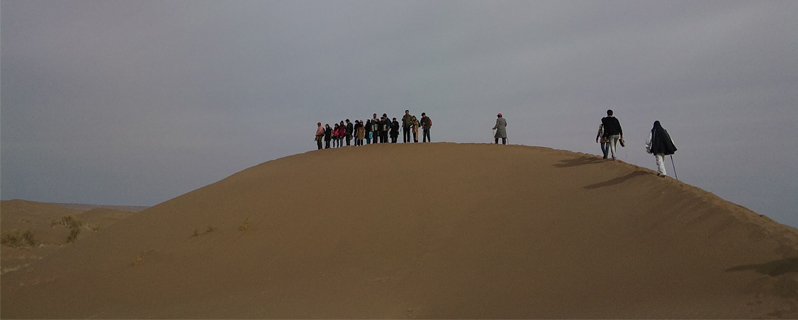
An ancient oasis in desert
“Garmeh is a wonderful village in the province of Isfahan, which gives you a great opportunity to walk. If you like fish spa, there is a small spring around the village that calms your leg.”
Need to know in Garmeh?
During your stay in the village and depending on your time, you can go for a walk in the palms garden. Then, put your feet in the spring with doctor fishes or climb the nearest mountain or hill to have a view of its surroundings.
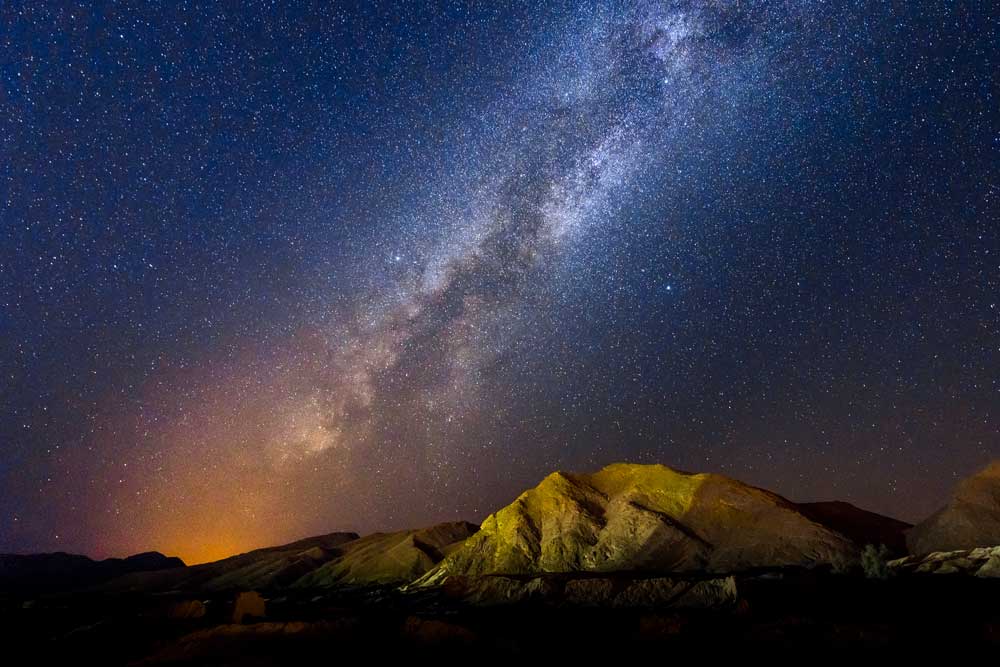
Starry Night in Garmeh Desert Village
You can also visit other villages nearby like Ordib, Iraaj and Dadkin with gardens and mountains, Bayazeh and its castle, Abgarm and its hot water. Furthermore, 80km from Garmeh to Jandaq you will find Mesr and Farahzad village and the dunes all around (https://ateshooni.com).
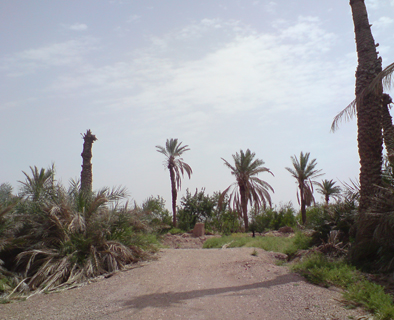
Palm trees garden, Garmeh
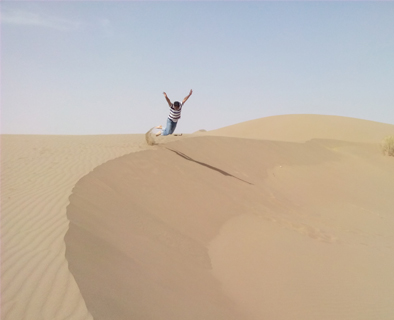
Enjoy you life!
A fire temple in Zoroastrianism is the place of worship for Zoroastrians, often called dar-e mehr (Persian). In the Zoroastrian religion, fire, together with clean water, are undoubtedly agents of ritual purity. Clean, white “ash for the purification ceremonies is regarded as the basis of ritual life,” which “are the rites proper to the tending of a domestic fire, for the fire temple is that of the hearth fire raised to a new solemnity.” For, one “who sacrifices unto fire with fuel in his hand …, is given happiness.”
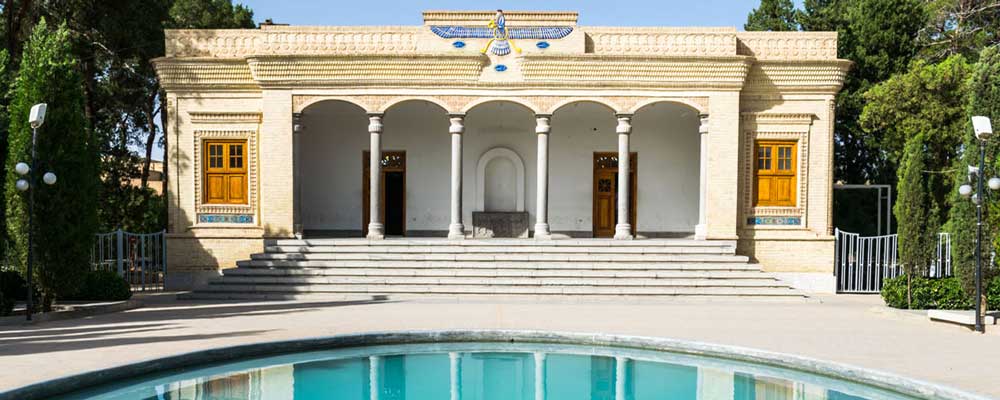
Zoroastrian Fire Temple in Yazd
Furthermore, the temple is located in Yazd, to the west of Shiraz, where Zoroastrians have practiced their religion since about 400 BC. It is situated on the Ayatullah Kashani Avenue and is 6 kilometers (3.7 mi) away from Yazd Airport.
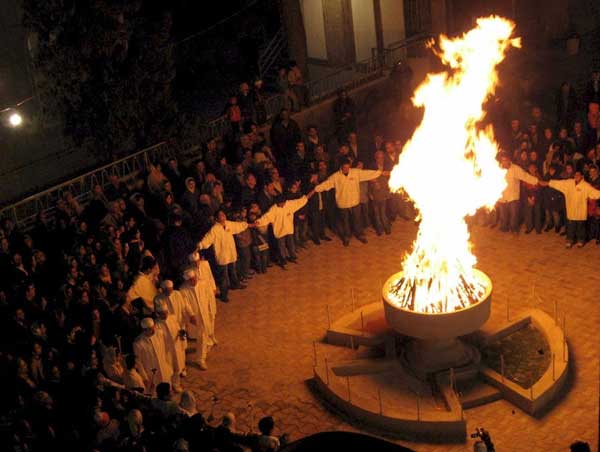
Zoroastrianism Ritual
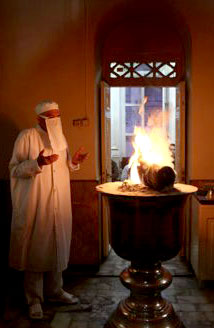
The highest grade of fire temples was first constructed in the Sasanian Empire for the reverence of fire, which is the manifestation of Ahura Mazda in the Zoroastrian faith. According to the Zoroastrian religion, this type of fire is consecrated by sixteen different sources, including the fire created by a lightning bolt. (source: Wikipedia)
Shakiba Travel Co.

Iran Tours
Call Us Today!
Whatsapp:
+98 912 054 0429
(DE) +49 178 391 2435
Email:
info@shakibatravel.com
Phone:
+98 31 366 98742
Fax:
+98 31 366 92756

